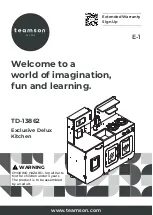
PREPARING FOR OPERATION
The locomotive must be serviced before being operated. It is important to
perform all the following operations. On radio controlled versions, the
equipment in the tender or coal truck must be connected to the engine.
Two flexible leads exit the engine through the rear buffer beam and
should be connected to the two leads emerging from the front of the truck
or tender. The plugs and sockets are marked with coloured dots to identify
correct pairs. Connect the two with red dots together and the two with
white dots together. Finally, couple the truck (by two link chain) or tender
(by the metal draw bar and a pin under the front of the tender) to the
engine. Use the hole in the drawbar that is furthest away from the back of
the locomotive unless you are running on straight track or have large
radius curves. FR Linda versions also have a dummy water pipe
connection on the right hand side. This is a long flexible tube attached to
the tender which is intended to slide on the brass rod which emerges
through a hole in the rear drag beam on the right hand side of the cab
footplate.
FILLING THE GAS TANK
The filling of the gas tank should only be carried out in a well-ventilated
area, where there are no naked flames or other lighted locomotives close
by. Ordinary Butane or Iso-butane gas (as used in gas cigarette lighters) is
the preferred fuel, and for economy, the larger canisters as used for
blowlamps or camping stoves etc. are better. The larger canisters have an
EN417 threaded self sealing valve on top and require a special adapter to
couple up to the filler valve on the locomotive. A special brass gas filler
adapter is obtainable from your local garden railway supplier or direct
from
ROUNDHOUSE.
Mixed gasses are also available and may be used
if ordinary butane or iso-butane are not available, but see the ‘Gas
System’ section for more information on this subject.
Before attempting to fill the gas tank, make sure that the gas regulator
control valve is closed by turning it clockwise. The filler valve is on top of
the gas tank in the right hand side of the cab and is accessed by lifting the
roof as described earlier. Invert the gas canister and place its nozzle over
the gas filler valve. Support the tank from underneath and press the
canister down. The gas will be heard hissing as it enters the tank and a
small amount will escape around the valve. This is quite normal and is the
6






































